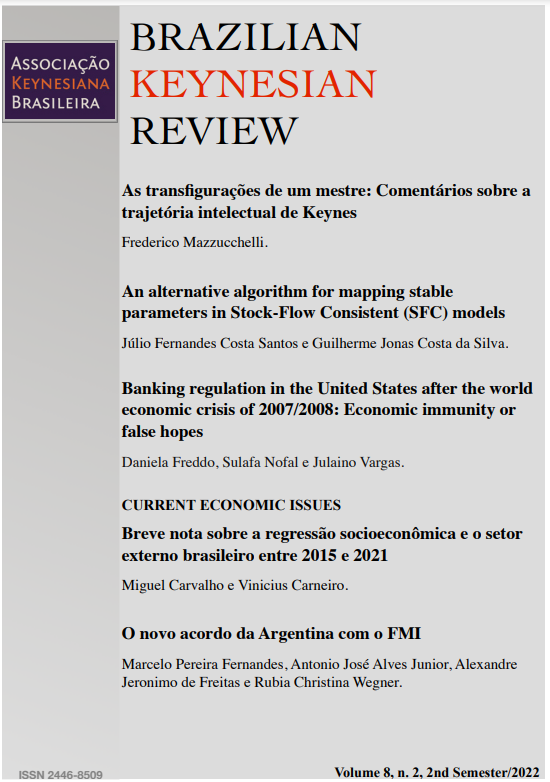Um Um algoritmo alternativo para o mapeamento de parâmetros estáveis em modelos Stock-Flow Consistent (SFC)
Resumo
O presente artigo desenvolve um algoritmo de análise de estabilidade através da junção das técnicas de simulação de Monte Carlo, Gauss-Seidel/Newton e Filtros de Variação. Para a comparação de resultados, utiliza-se tanto o algoritmo desenvolvido como uma solução numérico-analítica para o modelo Benchmark de Dos Santos e Zezza (2008). Os resultados mostram que há uma sobreposição entre os dois métodos de análise. Tendo em vista que nem sempre é possível ou viável a análise da estabilidade do sistema através de uma solução analítica, o algoritmo apresentado inova ao fornecer uma rota de fuga para o mapeamento de parâmetros estáveis em modelos dinâmicos SFC.
Downloads
Referências
Blecker, R. (2011). “Open economy models of distribution and growth”, In: Hein, E. and Stockhammer, E. A Modern Guide to Keynesian Macroeconomics and Economic Policies, Cheltenham, UK: Edward Elgar.
Caiani, A et al. (2016). “Agent based-stock flow consistent macroeconomics: Towards a benchmark model”. Journal of Economic Dynamics and Control, 69, p. 375-408. https://doi.org/10.1016/j.jedc.2016.06.001
Caverzasi, E.; Godin, A. (2014). “Post-Keynesian stock-flow-consistent modelling: a survey”. Cambridge Journal of Economics, 39(1), p. 157-187. DOI: https://doi.org/10.1093/cje/beu021
Ciuffo, B.; Rosenbaum, E. (2015). “Comparative numerical analysis of two stock-flow consistent post-Keynesian growth models”. European Journal of Economics and Economic Policies: Intervention, 12(1), p. 113-134. DOI: https://doi.org/10.4337/ejeep.2015.01.09
Dos Santos, C. H.; Zezza, G. (2008) “A simplified, ‘Benchmark’, Stock-Flow Consistent Post-Keynesian Growth Model”. Metroeconomia. 59(3), p.441-478. DOI: https://doi.org/10.1111/j.1467-999X.2008.00316.x
Elaydi, S. (2005) An Introduction to Difference Equations. Nova Iorque. Springer.
Lucas, R. E. (1976). “Econometric policy evaluation: A critique”. Carnegie-Rochester Conference Series on Public Policy, 1, p. 19–46. DOI: https://doi.org/10.1016/S0167-2231(76)80003-6
Kinsella, S.; O’shea, T. (2010). “Solution and Simulation of Large Stock Flow Consistent Monetary Production Models via Gauss Seidel Algorithm”. Journal of Policy Modeling. DOI: http://doi.org/10.2139/ssrn.1729205
Gandolfo, G. (2009). Economic Dynamics. 4th Edition. Springer.
Godley, W.; Lavoie, M. (2007). Monetary economics: an integrated approach to credit, money, income, production and wealth. 1ª ed. Nova York: Palgrave Macmillan.
Godin, A.; Aliti, G. T. Kinsella, S. (2012). “Method to Simultaneously Determine Stock, Flow and Parameter Values in Large Stock-Flow Consistent Models”. Working Paper. DOI: http://dx.doi.org/10.2139/ssrn.2094996
Grasselli, M.; Pelinovsky, D. (2008). Numerical Mathematics. Jones & Bartlett Learning.
Macedo e Silva, A. C. (2008). “Missing Details and Conspicuous Absences: From the Treatise to the "General Theory"”. Journal of Post Keynesian Economics, 31(2), p. 325-44. DOI: http://doi.org/10.2753/PKE0160-3477310207.
Macedo e Silva, A. C.; Dos santos, C. H. (2011). “Peering over the edge of the short period? The Keynesian roots of stock-flow consistent macroeconomic models”. Cambridge Journal of Economics, 35(1), p. 105-124. DOI: https://doi.org/10.1093/cje/bep083
O’shea, T.; Kinsella, S. (2010). “Solution and Simulation of Large Stock Flow Consistent Monetary Production Models via the Gauss Seidel Algorithm”. Journal of Policy Modeling, Forthcoming. DOI: http://dx.doi.org/10.2139/ssrn.1729205
Ruggiero, M. A.; Lopes, V. L. R. (1996). Cálculo Numérico: aspectos teóricos e computacionais. 2ª edição. São Paulo: Pearson Makron Books.
Shone, R. (2002). Economic Dynamics. Phase Diagrams and their Economic Application. 2nd Edition. Cambridge University Press. New York.
Viana, R. L. (2012). Introdução à Dinâmica Não-Linear e Caos em Economia. Notas de Aula. Universidade Federal do Paraná.
Copyright (c) 2022 Júlio Fernando Costa Santos, Guilherme Jonas Costa da Silva

This work is licensed under a Creative Commons Attribution 4.0 International License.
- Autores mantém os direitos autorais e concedem à revista o direito de primeira publicação, com o trabalho simultaneamente licenciado sob a Licença Creative Commons Attribution que permite o compartilhamento do trabalho com reconhecimento da autoria e publicação inicial nesta revista.
- Autores têm autorização para assumir contratos adicionais separadamente, para distribuição não-exclusiva da versão do trabalho publicada nesta revista (ex.: publicar em repositório institucional ou como capítulo de livro), com reconhecimento de autoria e publicação inicial nesta revista.
- Autores têm permissão e são estimulados a publicar e distribuir seu trabalho online (ex.: em repositórios institucionais ou na sua página pessoal) a qualquer ponto antes ou durante o processo editorial, já que isso pode gerar alterações produtivas, bem como aumentar o impacto e a citação do trabalho publicado (Veja O Efeito do Acesso Livre).


